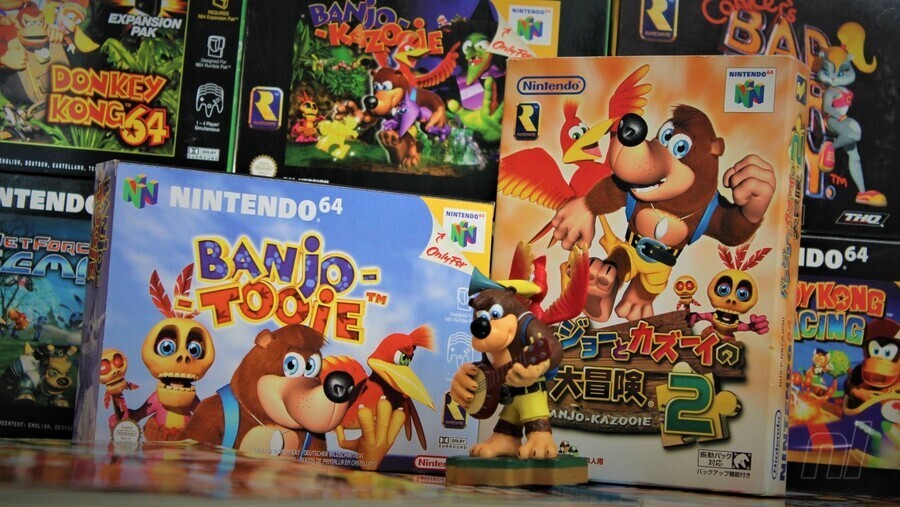
Nowadays, there's nary a game that doesn't finish with a post-credits tease to tee up a sequel or spin-off. There's always a tantalisingly loose thread or Easter Egg hidden in the DLC hinting at a further instalment. It would be a very bold move, though, to name your sequel and directly reference it in a game that hadn't even released yet.
Rare's 3D platformer Banjo-Kazooie was arguably the first credible challenger to square up to seminal Nintendo 64 launch game Super Mario 64. With large, colourful 3D worlds to explore, a cast of loveable characters and a dash of British naughtiness in its humour, it became a fast favourite with fans. It also finished with possibly the best sequel bait in video game history, with the titular bear and bird taking a well-earned break at the beach after their adventure before shifty shaman Mumbo Jumbo shows up with a set of animated polaroid pictures showing inaccessible areas you 'missed' with secrets which would be used in the next game.
The team must have been confident in what they had, but was Banjo-Tooie—the ambitious follow-up which launched in North America on 20th November 2000—genuinely on the cards before the first game even released?
"Yes it was," confirms Gregg Mayles, designer on both platformers, "but only as a name and us wanting to include the ‘Stop n’ Swop’ items that formed a link between the two games. What Tooie would actually be had not been thought about at that point!"
"There was a positive reaction to what we showed publicly," says head programmer Chris Sutherland, one of several Banjo veterans that would go on to found Playtonic Games and recapture the Banjo spirit in the Yooka-Laylee series. "There were a bunch of ideas that never made it into the first game, so it seemed like the sensible thing to do to move onto a sequel. Some of the team originated from DKC games so in some ways it mirrored how we'd rolled straight onto DKC2 from DKC1... I guess it also puts Banjo-Kazooie into a shortlist of "games that (successfully) announced the name of their sequel in the game"!"
The moody second act
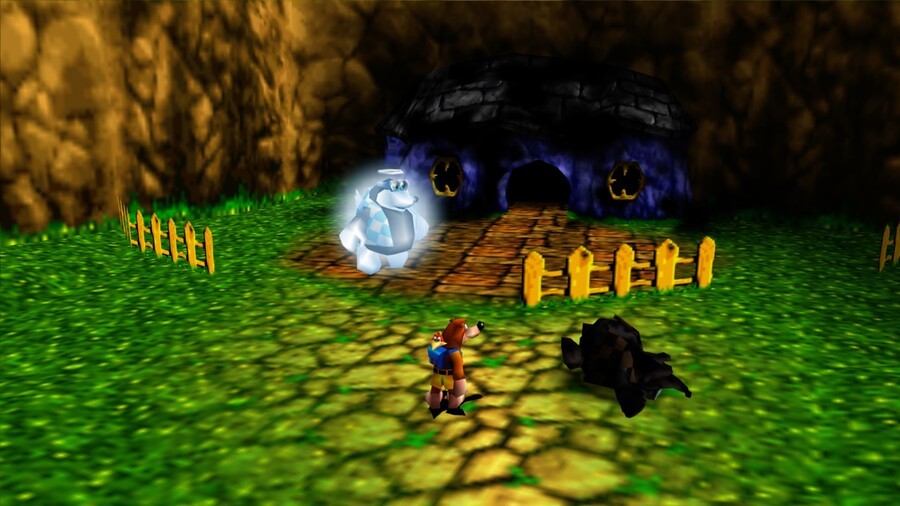
From the very beginning, Banjo-Tooie feels darker—a little more dangerous, a little less forgiving—than the previous game. It's still very much a fairytale romp but from the off Tooie leans into Brothers Grimm-style darkness. Bottles (bespectacled, move-teaching mole and stalwart pal to the protagonists) meets his demise at the hands of Gruntilda in the introduction cutscene, and mere moments after making the friendly Jinjo King's acquaintence, he's transformed into a shambling zombie by the vengeful witch.
"It was deliberate," Mayles says of the classic ‘darker second act’ approach. "We didn’t want to do the same thing again as the first game and we wanted to surprise players. I don’t think anyone would have expected us to kill off one of the main supporting characters and I can remember us laughing when we plotted Bottles’ downfall. There were some pretty dark and mature elements to the tone that we tried to balance out with our sense of humour, I think my favourite was when Bottles’ family was asking about him and Banjo had to pretend he didn’t know the mole was no more."
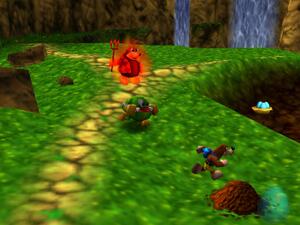
Bottles' angelic spirit lingers where he fell outside Banjo's house in Spiral Mountain, and a devilish alter ego was intended to return in the canned Bottles' Revenge mode which would have allowed a second player to take control of NPCs.
"I guess we were seeing how much fun we could have with the characters and worlds," says Steve Mayles, head artist and brother of Gregg. "When you’re making a sequel there is a natural progression of things I think, you want to push the envelope a bit more. Bottles got what was coming to him anyway, he was pretty annoying in Banjo-Kazooie!"
That slightly grimmer tone influenced the musical direction. "I think I just felt that it was a darker game," composer Grant Kirkhope tells us. "The levels were definitely less jolly then the first game. Honestly I was pretty much left to my own devices by this time, I think Gregg Mayles had finally grown to trust me …. ha!" Having established himself in Rare's luminary stable of composers, Kirkhope was more-or-less left to get on with it on the sequel. "I don’t think I had to make any changes to the music on Tooie, those pieces were all my first ideas."
Design duties on Tooie were shared between Mayles and Steve Malpass, freshly-promoted in his first design role. "I started in QA as most wannabe designers did at Rare back then, so Gregg was training me up on the job," he tells us. “[Gregg's] previous assistant designer had left the team to head up DK64 and he needed a replacement.”
Another big game that came along while we were making it was Metal Gear Solid, which we loved. Games just seemed to be growing up a bit.
The sequel's bleaker tone and expanded ambitions were influenced by trends and titles of the day. "Tooie was intended to be more of an adventure and less of a platform game than Banjo-Kazooie," Malpass explains. "There was a desire to make the environments feel interconnected and part of some larger world, hence why you can only reach certain areas in one level by accessing them from another. The Legend of Zelda: Ocarina of Time came out at the end of 1998, while Tooie was still in early development, which only backed up that idea."
"So with that extra level design complexity also came a slightly more grown-up story, even though it was still intended to be funny and appeal to all ages. The direction was all down to Gregg but I certainly remember agreeing it was the way to go. Another big game that came along while we were making it was Metal Gear Solid, which we loved. Games just seemed to be growing up a bit."
Getting down to design
With two designers at the helm and ideas left over from the previous game, there wasn't a lot of pre-production. Tooie was more of a 'get stuck in' project, especially for Malpass who was learning on the job.
"To begin with we were coming up with ideas for tasks, puzzles, level features, etc. That stuff always came first, with the worlds designed to accommodate them, never the other way around. Gregg had lots of stuff for the first few worlds left over from Banjo-Kazooie so he did the level design for those. Then he showed me how it was done and I got involved in that, so the design of the worlds in the second half of Tooie was more of a joint effort. Level design seemed like a bit of a dark art at first so it felt like a real achievement when my stuff made it into the game. Though I found it difficult to begin with, with lots of rules to bear in mind. It was all done on paper as maps and sketches back then, followed by lots of iteration with the environment artists. You couldn’t just quickly build a 'grey box’ level like you can in Unity or Unreal now."
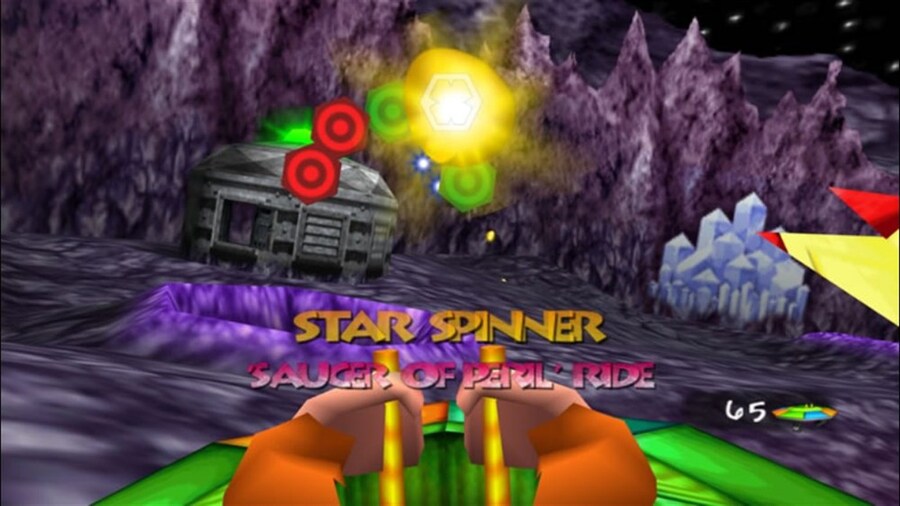
Though modern titles and consoles are far more complex, improved tools make the task of creating a video game much more user-friendly these days. Back in the late '90s, designers at Rare were using the N64's controller itself—one of console gaming's most 'Marmite' of pad designs—to interface with the editor.
having to create something like a camera spline with an N64 pad and then tweak it to make the movement feel realistic was quite a chore
"We shared the setup work using the clunky in-game editor (with an N64 pad!) to place collectable items like music notes, invisible volumes (triggers for characters, cameras, etc.) and such," explains Malpass. "Designer tools were usually a pain to use because there were no established tools for us as there are now. All the tools for Banjo were written by a programmer on the team, with scant regard for usability as their time was better spent on the game itself. So having to create something like a camera spline with an N64 pad and then tweak it to make the movement feel realistic (e.g., the Saucer of Peril ride) was quite a chore, as such things are much easier with a keyboard and mouse. Pretty much everything that involved using that editor was a faff, really."
As the veteran of the pair, Mayles had the final say on design elements. "Almost everything went through Gregg, so ultimately he decided what ended up in the game, which was great for consistency. But he was always very fair at picking what he thought was best for the game, regardless of who came up with it. There was only the two of us as designers on the entire game, so the work was very varied and I learned a huge amount in a relatively short time, as you can imagine. It was daunting, because there was a lot to learn, but it was also fun and relatively stress-free, as I recall."
Friendly rivalries
The turn of the millennium was a particularly fertile time for the Twycross-based studio, and Rare had a bevy of quality platformers on its books. Donkey Kong 64 launched in November 1999, Tooie released a year later in North America (although it wouldn't arrive on European shores until the following year) and Conker's Bad Fur Day launched just a handful of months after that. That's a whole lot of colourful 3D platforming from the same company on the same console in a relatively short space of time.
"Looking back it seems an utterly bizarre thing to do… it certainly wouldn’t happen these days!" says Gavin Price. "I can imagine there was a fair bit of concern amongst some teams about shipping titles close to each other – I was in QA so not really exposed to what each teams opinion on the matter may be... I think it probably caused more rivalry problems than benefits in the long-run sadly."
At that time 3D platformers were so popular I don't think we were concerned about having multiple examples of the genre as long as they distinguished themselves from each other in some way.
Rare's practice of separating teams across its infamous 'barns' naturally created some competition. "I'm not really sure we thought about that at the time," remembers lead environment artist Steven Hurst. "In those days each team worked in relative isolation and competed against each other to develop the 'best' games – a healthy rivalry if you like. I do remember actually that we changed BK to be more of a 'proper' 3D game (similar to Mario 64) after seeing the work that the Conker team were doing. Up until that point BK was more akin to a 3D game playing in a 2D plane with a fixed camera. Changing to a fully 3D game gave us more gameplay opportunities. At that time 3D platformers were so popular I don't think we were concerned about having multiple examples of the genre as long as they distinguished themselves from each other in some way."
Secrecy around the projects inevitably generated hearsay around the studio. "Grant [Kirkhope] was always a great source of gossip," remembers Malpass, "as the musicians tended to be involved with multiple projects. But Gregg, being someone [joint studio head] Tim Stamper probably trusted most, got to play and feedback on the other games periodically, so he knew mostly what the other teams were up to."
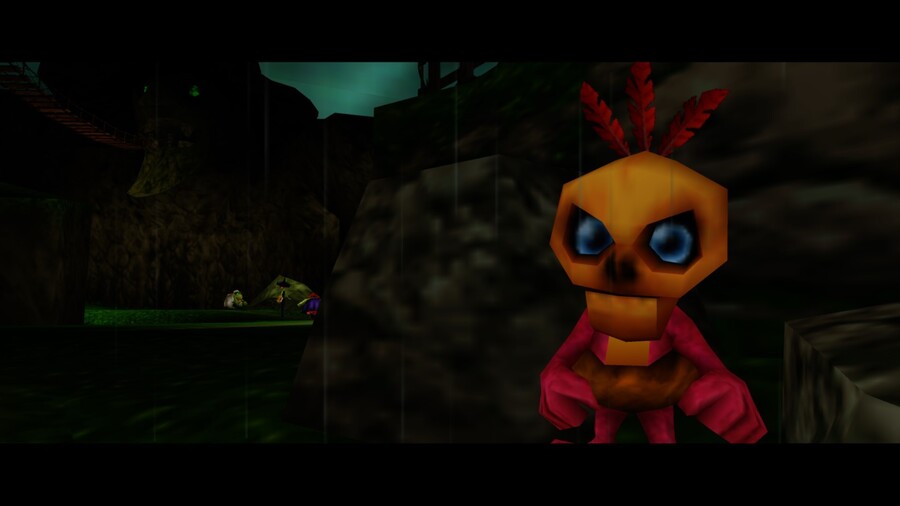
"Rare was famously secretive," Steve Mayles recalls, "and that included other games being made in the company. Many people on the team wouldn’t have seen much (if anything) of DK64 and Conker. With Banjo Kazooie, we’d created a game that seemed to be universally popular, so there was no reason to think the sequel wouldn’t be received just as well, regardless of what other games were being released. Also, I think Banjo-Tooie had a different enough identity when viewed against other Rare platformers."
Rare was famously secretive, and that included other games being made in the company. Many people on the team wouldn’t have seen much (if anything) of DK64 and Conker
The teams were obviously conscious of this confluence of quality 3D platforming and made tweaks to give them different flavours. 'Twelve Tales: Conker 64' and its bushy-tailed protagonist were famously restyled to feature the foul-mouthed squirrel we know and love who ended up having a Bad Fur Day.
"I remember being aware of the new direction and that their humour was very in-your-face and ‘mature', compared to Banjo’s, which is more subtle and laden with innuendo," says Malpass. "The gameplay of Conker was very different too, relying heavily on movie references and set-pieces, so it seemed enough of its own thing. DK64 was being led by George Andreas, who was Gregg’s no. 2 on Banjo-Kazooie, so Gregg was much more involved in overseeing the design of that. Some of our artists were helping out on it from our building too, so we got to see bits and pieces and were well aware there were things in common."
Overall, Rare's segregated approach produced some impressive results. "You occasionally get to see another team's game," recalls senior artist Ed Bryan. "It was always fun to see what the others were up to. I think we worked on the idea that the games were different enough, with their own mascots and their own kind of style, that players would want to play all of them. Within the team it was always nice to see other stuff as it helped to focus what you were doing; you can see how others have approached art problems, design problems, that sort of thing. It keeps you on your toes!"
Steve Malpass agrees. "It just created a bit of friendly rivalry and motivated us to try and make our game as good as we could. There may have been concerns higher up about the similarities but they were some of the sorts of things Rare was renowned for, so I don’t remember any great panic about it."





Comments 43
And then one of my beloved franchises got bought by Microsoft and the franchise went completely downhill
One of my all time fav's!
As a huge fan of the first one, I find it incredibly bizarre that I've never played this game, I have no idea what it's like, and I've never even seen footage lol. I remember there being zero hype and very little marketing, and it was just there on the shelf at Hastings one day. Its a white whale game for for me for sure
Why Nintendo didn't just say yes to buying them and turning them into a second party developer will always perplex me given the legacy of those games on SNES/N64
Bash Microsoft all you want but they were literally just stepping in to answer to Rare's pleas for an acquisition when Nintendo turned them down. I don't even think they had a factor in how Nuts & Bolts became Nuts & Bolts
@AndyC_MK Honestly Rare during the XB1 era whether they were licensing out IPs or making original stuff are considerably better than during the 360 era, and that Everwild game looks visually interesting
I wouldn't say they've declined but they did have a meager output for some time but they seem to be back on track in general.
And also Capcom is doing fine? They had a small dark period in the early 2010s but they've been really excelling considerably since Resi VII. They're far from doing badly
Imagine being a company that owns an IP as strong as this one and doing virtually nothing with it for over 15 years. Why did Microsoft even buy Rare? Sea of Thieves has it's pros but you can't tell me a studio as large as Rare has nothing else to show the last several years.
I’m going to play through this again soon. On Xbox one though........ wish it or rare replay was on switch 😫
"So with that extra level design complexity also came a slightly more grown-up story, even though it was still intended to be funny and appeal to all ages."
face slap
Complete tonal change away from what made nonsense (but whimsical and fun nonsense, it is magic after all) in the first game. You can't possibly take a serious tone with a pair of furballs with no better sense than to live next to a witch's lair with a giant carved head for an entrance. Conker could because it parodied all kinds of things and went for the Ren and Stimpy approach elsewhere.
I will play and replay Banjo-Kazooie for a very long time.
I have gotten as far as the first FPS segment in Tooie before becoming bored with the game and fed-up with the tone.
It's pretty rare to see developers discuss a 20-year-old game, but I'm not complaining, this is so cool
@AndyC_MK84 I know you asked the other guy, but I gave Yooka-Laylee a shot.
Gotta say it does retain that classic banjo feel, the humor is pretty good as well.
Haven't gotten far into it though but thats mostly adulting to blame.
Will Banjo-Tooie ever be released on Nintendo Switch during my lifetime? That's all I would wish for a 20-year birthday...
@AndyC_MK84 aye dude I know what you mean. I also got a huge list of games I haven't been able to play yet.
Once I eventually finish Yooka Laylee I'll get into Impossible Lair.
Just rebought this game on my Xbox 360 (yes, I still buy games on that workhorse). This inspires me to fire it up. Been several years since I’ve played Banjo-Tooie.
@AndyC_MK84 Backed it, got wary at the minecart, the plot came from the wrong place and didn't have the right spirit, and so I asked for a refund.
I've heard it's mediocre when compared to Banjo-Kazooie, but it might still be serviceable in the same way that Super Lucky's Tale is.
Still the most enjoyable 3D platformer I have ever played, such great characters and you could tell that Rare had a lot of fun making it, it really showed! What a gem of a game, such a shame we never got a proper third entry, a travesty really.
@AndyC_MK84 hey man, just thought I’d jump in too. As a HUGE fan of BK, I was so excited for YL and played it to 100% completion.
It certainly had the feel of a Banjo game but perhaps a little too much - often it felt like a game trying desperately to recreate those memories and ended up not really having a personality of its own. It also wasn’t helped by the assumedly smaller budget as the polish was for sure missing: bugs, large empty worlds and repetitive design, all once again making it feel like a team trying their best to recreate a beautiful series under more limitations.
All that said, however, the hours did fly by while I played it. I’m a sucker for a good 3D platformer and I had a good time playing this. It has a whole suite of issues and sometimes comes off as safe and somewhat pandering but hey, it’s a bunch of talented guys making a game and that talent does shine through quite often.
In short, I’d probably recommend giving it a go, just don’t expect it to light your world on fire and, if you’re a fan of Rare’s old output, you should have a good time
One of those games that, as a proud N64 owner, I inexplicably passed up on. Along with, uh, Mario 64.
Thanks to All-Stars, I rectified that last oversight. But Banjo's still pending.
@AndyC_MK84 Sea of Thieves has at least been improved year-by-year. It's a great game. Definitely different from previous Rare output. I'm with you though.
Will get around to this when I get my Series X (eventually). Loved Nuts and Bolts but never had the first 2. Strangely enough played the 2 GBA games as well.
@AndyC_MK84 Killer Instinct 2013 is lauded as one of the best (if not THE best) fighters of this past generation though. It may get another on Series X.
As for Rare not being as prolific I think that is incredibly harsh, games take far longer and much more manpower to make these days so naturally they aren't going to make as much. What they have is fantastic by all counts.
I may be very alone in this but I think the Microsoft buyout has worked out well. Kameo, PDZ, Banjo 3 and Viva Pinata was out of left field but oh so good. Not had a chance to play the last gen output from them but I will be putting that right in the future (not Kinect though, just no).
I read an interview with Phil Spencer where he said he leaves it in effect up to developers to make what they want, seems Rare doesn't really want to jump back into what they used to make which is fair enough, most of their beloved games were fresh new ideas.
I’d kill for the Rare Replay Collection on the Switch. C’mon MS! C’mon Nintendo- put aside your differences and give us what we want!
@Arkay is your icon from a computer monitor in Goldeneye 64? I remember that gif vividly.
And just like Mario and Sonic on their anniversaries, don't expect anything big like an entirely new game.
Banjo and Kazooie are my favourite video game characters.
PLEASE STOP DOING THIS TO ME! I keep on thinking this is going to be the article that leads on to them being released on switch
The most impressive adventure/3d collect-a-thon game of all time to me
@0blivion yes it is! You're the 2nd person that recognized it so far . : P
@Arkay I’m very impressed you’d use such an obscure image. Kudos.
I feel like this series is more obscure than people realize
Probably the best true collectathon platformer ever made. Love this game.
Please give us a new Banjo game for switch or even a Remaster.
@ArmenianJedi13 well it’s hugely famous within the industry but yeah 20 years since their last ‘proper’ game, so a whole generation of gamers will have missed out on the franchise.
What a coincidence, I just completed this game yesterday for the very first time after 20 years of trying. Although I had to use honeyback cheat (Earned cheat) on Hag 1. Did everything else 75 jiggies up that point without any cheats on.
Always excited to read how a beloved series was made
Seriously though i hated Banjo-tooie back then and to this day i still hate it. Didn't like any of the levels. So forgettable compared to the iconic ones , of the first game.
Banjo-Kazooie is probably my favourite game of all-time, I try to replay it every once in a while but because I don't have an X-Box 360/one and my N64 is no longer connected I have to resort to emulation.
Unfortunately emulation is annoying as there are some graphical imperfections that are hard to resolve without it causing other issues...
However, as much as I love B-K I can't say the same about B-T. Even at the time of release I felt it was too big and it made game more of a slog to 100%. I replayed it to 100% recently and my thoughts haven't changed.
What makes B-K so great is that it's not filled with padding and backtracking, I once 100% completed it in 4,5 hours and I wasn't even speedrunning (because I hate that).
DK64 is the worst of the bunch though. I did enjoy my latest playthrough on Wii U to some extend but it feels like B-T/B-K with a DK skin and it lacks any of the charm of both.
@AndyC_MK84 I think that yeah to most their output hasn't been stellar, especially the Xbox One era or the Kinect works, I do think that 360 era produced some of their best work though.
And fair enough if you think their games haven't been as value for money, everyone has their own take on that and none are wrong.
Release Banjo Kazooie and Banjo Tooie on the Nintendo Switch!!!
Rare studios had all my top favorite games on the N64, especially Banjo and Donkey Kong 64. It's a shame Microsoft bought them out. My old Nintendo 64 broke ages ago. It freezes between 5 to 30min of continuous gameplay so I have to emulate Banjo to play it, fortunately, almost any old low-end computer can manage to emulate an N64 game as long as the CPU isn't too much older than 12 or 13 years.
That was a great lunchtime read! Thank you @dartmonkey
Huge fan of the BK series (and Rare!) — I think the BK games were the first games I reviewed when we launched a ‘retro’ review section on NintendoLife.
I’m currently on yet another playthrough of the series right now on my Xbox. Love all three games for what they bring — the first I think is flawless, and the other two are near flawless (this article makes me realise that by doing something different than a copy and paste sequel is refreshing - Rare trying to innovate and evolve is so important). After just going into Mario 64 it cements my view that BK was the best platformer on the 64). 22 years on and I am just loving the original and have completed it well into the double digits.
I actually got my fingers tattooed the other day with a feather, jiggy, note and honeycomb in homage to these amazing games.
@Nanaki Glad you enjoyed it!
@AJDarkstar Typos? Let me know where and I'll zap them.
Never liked Banjo-Tooie. Even if i completed it back then i can't recall any of the levels . The only thing i remember was that each stage was huge and mostly empty. Compared to the first game were every stage was so iconic i think Banjo-Tooie was just bland
I hope they release Banjo Kazooie and Banjo Tooie on the Switch!
Not my favourite game...by the time I had finished it, I was sick of it
Personally I'd love to see Nuts and Bolts released on Switch. I've never understood why that one didn't eclipse the first two....definitely my fav, spent hundreds of hours discovering the secrets of that game.
Tap here to load 43 comments
Leave A Comment
Hold on there, you need to login to post a comment...